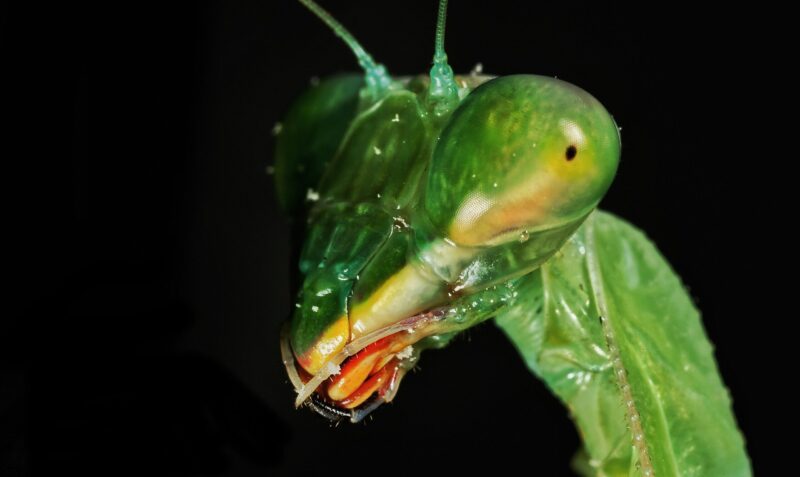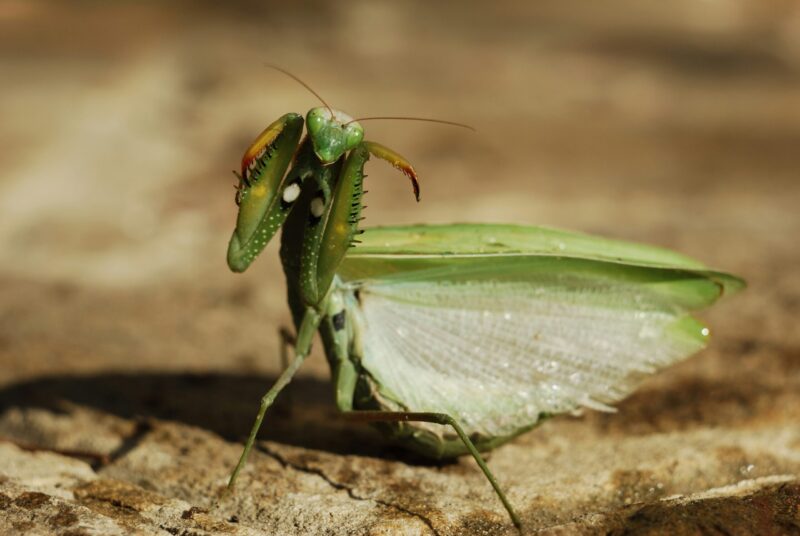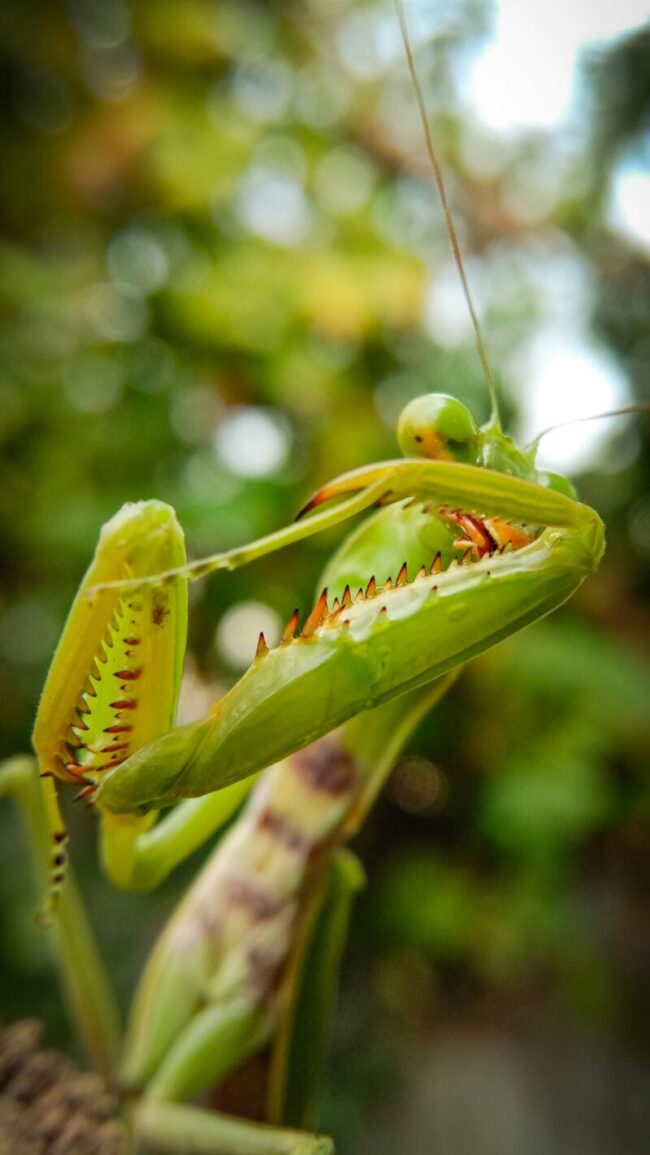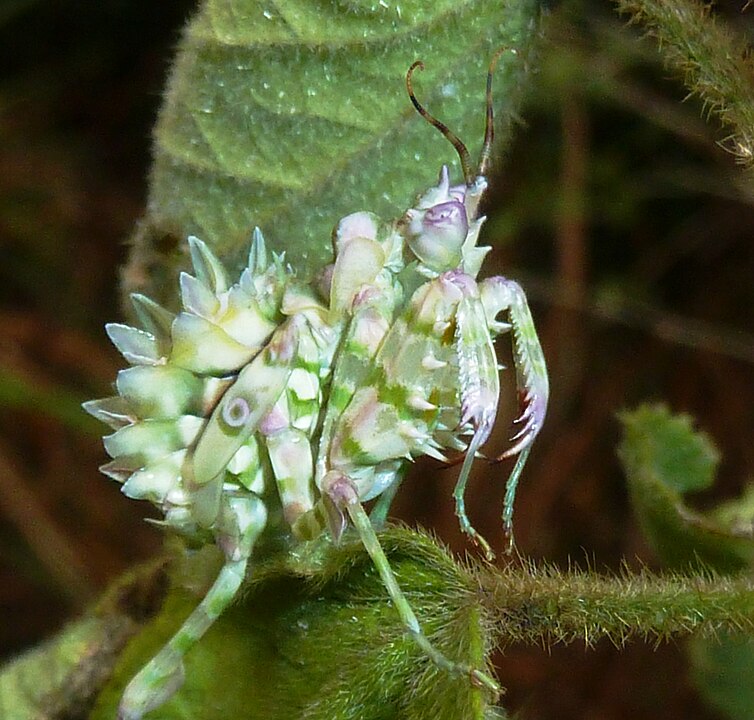The praying mantis is a vicious predator. See more in this video.
The praying mantis is more of a preying mantis, because it’s a ruthless predator. It doesn’t hesitate to eat any insect that comes its way. It can even hunt and eat small reptiles, mammals, amphibians and birds. Not even its own mate is safe. And to top it off, it eats its prey while it’s still alive.
The word mantis comes from the Greek mantikos, which means seer or prophet. These insects look like they’re in holy contemplation, as their front legs fold together as if in prayer. In fact, most mantises are known by their common name, praying mantis.
The praying mantis
These insects measure between 2.3 to 2.7 inches (6 to 7 cm) and have a carnivorous diet. They move ultra-fast when they hunt. There are around 2,400 species of mantises. Some have wings and others don’t.
They have a lifespan of one year and are found in temperate and tropical areas, but you might see them in deserts, too. They’re quite common in Europe, Asia, Africa and almost all of South America. Farmers introduced mantises to North America in the 1800s to help get rid of pests. Now they’ve spread across the entire continent. In fact, the mantis is Connecticut’s official state insect.

The impressive vision of the praying mantis
The mantis has enormous compound eyes that allow it to see depth and movement in a wide field of view. The compound eyes are made of thousands of light receptors called ommatidia. Their density increases in the central part of the eye, where its sight is most precise. But the peripheral ommatidium are responsible for perceiving movement. So when a mantis sees moving prey, it quickly turns its head to put the prey in its front visual field. Then it follows the prey to keep the image centered. The head can rotate up to 180 degrees.
Those two little black dots in its eyes that seem to follow you when you move are not pupils but light receptors called pseudopupils. The little black dots absorb all wavelengths of light, which is why they’re black. The light receptors around the black dots reflect specific wavelengths, so the rest of the eye appears green, white, brown or violet.
But the praying mantis also has another three, smaller eyes between the larger two. These small eyes go by the name ocelli. These simple eyes are common in arthropods. The photosensitive cells help the insect perceive light and shadow.

3D vision
As if these impressive eyes weren’t enough, the praying mantis is the only invertebrate known to see in 3D.
Mammals use their pupils to focus light on the retina and form an image in their brains. So even though the mantis doesn’t have pupils, but pseudopupils, it can create a 3D image.
In this case, 3D vision is based on movement. For a motionless predator, the background image is almost as important as the movement of the prey. The mantis must consider how far away its prey is without movement that would alert the prey.
Normally, 3D vision is typical of primates and more complex animals. Still, these little insects, which only have a million neurons in their brains – compared to the human brain’s 100 billion – have designed their own way of seeing in 3D.

Hearing and movement
The praying mantis can detect the ultrasonic frequencies that bats use to hunt. The mantis uses an organ similar to the ear, but it’s not in the insect’s head. Instead, it’s located in the center of the chest, in the thorax. These insects can hear sounds above 20,000 hertz, outside the human hearing range.
Some mantises have wings and fly. When flying species are moving in the air, they can detect the sounds bats use to approach their prey. Consequently, mantises change their flight path to avoid capture.
Praying mantises are primarily diurnal (active in daytime), although some species move at night and may be attracted to artificial lights. Also, mantises jump with extreme precision by contorting their body in the air to land on the objects they want.

What does a praying mantis eat?
Mantises are voracious, carnivorous insects that feed on any other nearby insects, such as flies, crickets, grasshoppers, beetles, moths, butterflies and bees. However, it is not uncommon for larger mantises to devour spiders, birds, small mammals, amphibians and reptiles. Thus, you can see the mantis hunting and eating hummingbirds, mice, frogs, lizards, snakes …
Fortunately for us, the mantis isn’t poisonous and doesn’t have a sting. Additionally, the mantis can provide useful pest control for gardeners, as it eats potentially destructive insects.

How do mantises hunt?
To capture its prey, the mantis camouflages itself in the surrounding area and waits for prey to come within striking distance. Once in position, the mantis uses its front legs to grab the prey. These legs are like saws, with spikes that dig into the prey and prevent it from escaping.
And – here’s why we call it a ruthless predator – mantises don’t inject poison or use other more merciful methods on their prey. Instead, the mantis eats its prey while it’s still alive. Not only that, but mantises have a rather gruesome method of devouring their prey: They start with the head. In many cases, the insects bore into the birds’ heads and feed on their brains. Yuck!
Praying mantises have hunting instincts from birth. From the moment they’re hatched, they’re independent and begin training to look for small prey such as larvae or worms. Later, once their skills improve, their size increases and they become faster, they start hunting larger insects and animals.
If threatened, the mantis stands upright and extends its front legs in defense. Additionally, a mantis species with wings will spread them to appear larger and scare the opponent. If the confrontation persists, the mantis will strike the attacker with its front legs and try to pinch, bite or cut it.

Mating
The adult female emits pheromones to attract males, which helps them locate less-mobile females. The females are much larger than the males. This difference in size is because females must produce hundreds of eggs. In addition, a larger size can help them protect their eggs from predators.
During the breeding season, female mantises can devour their partner. Normally, if other prey is available, the male can rest easy. However, a hungry mantis will devour the male after mating.
The percentage of species that carry out this practice is between 13% and 28%. Why do they eat their mates? The belief is the females need an important supply of amino acids for their eggs, so they can successfully develop.
The mantis begins its life in a slimy mass of eggs called an ootheca. Generally, the ootheca starts out foamy and then hardens to ensure protection. When autumn comes, the mantis creates this mass on a small branch. The eggs hatch from spring to early summer, as warmer temperatures mark the time of hatching.
Wings, colors and camouflage
Some species have bright colors and patterns on their wings, body and the inner surface of their front legs, which can also produce sounds. Some mantises don’t develop wings at all, or they may have small flightless wings. If the mantis is winged, they’re located on its abdomen.

Normally, it’s more common for females to have a limited ability to fly, because they’re larger than males. On the other hand, males frequently use their wings to search for females or escape them when copulation is over.
Each species has different morphological characteristics. Normally, mantises develop an appearance that resembles their environment in order to camouflage themselves and hide from predators. This also allows them to hunt without being seen.

The perfect example is the orchid mantis (Hymenopus coronatus). When it’s barely born, this expert in the art of camouflaging has a red-and-black color pattern, similar to bedbugs. This is a good trick, since its predators hate the taste and smell of this bug. When it grows and becomes an adult mantis, its colors turn white and pink to camouflage itself among the orchid flowers, handy for stealth hunting.
Bottom line: The praying mantis is a ruthless predator that eats any insect that comes its way. Not even small reptiles, mammals, amphibians, birds or its own mate are safe.
The post The praying mantis is a predator: Lifeform of the week first appeared on EarthSky.
from EarthSky https://ift.tt/BOyjCLa
The praying mantis is a vicious predator. See more in this video.
The praying mantis is more of a preying mantis, because it’s a ruthless predator. It doesn’t hesitate to eat any insect that comes its way. It can even hunt and eat small reptiles, mammals, amphibians and birds. Not even its own mate is safe. And to top it off, it eats its prey while it’s still alive.
The word mantis comes from the Greek mantikos, which means seer or prophet. These insects look like they’re in holy contemplation, as their front legs fold together as if in prayer. In fact, most mantises are known by their common name, praying mantis.
The praying mantis
These insects measure between 2.3 to 2.7 inches (6 to 7 cm) and have a carnivorous diet. They move ultra-fast when they hunt. There are around 2,400 species of mantises. Some have wings and others don’t.
They have a lifespan of one year and are found in temperate and tropical areas, but you might see them in deserts, too. They’re quite common in Europe, Asia, Africa and almost all of South America. Farmers introduced mantises to North America in the 1800s to help get rid of pests. Now they’ve spread across the entire continent. In fact, the mantis is Connecticut’s official state insect.

The impressive vision of the praying mantis
The mantis has enormous compound eyes that allow it to see depth and movement in a wide field of view. The compound eyes are made of thousands of light receptors called ommatidia. Their density increases in the central part of the eye, where its sight is most precise. But the peripheral ommatidium are responsible for perceiving movement. So when a mantis sees moving prey, it quickly turns its head to put the prey in its front visual field. Then it follows the prey to keep the image centered. The head can rotate up to 180 degrees.
Those two little black dots in its eyes that seem to follow you when you move are not pupils but light receptors called pseudopupils. The little black dots absorb all wavelengths of light, which is why they’re black. The light receptors around the black dots reflect specific wavelengths, so the rest of the eye appears green, white, brown or violet.
But the praying mantis also has another three, smaller eyes between the larger two. These small eyes go by the name ocelli. These simple eyes are common in arthropods. The photosensitive cells help the insect perceive light and shadow.

3D vision
As if these impressive eyes weren’t enough, the praying mantis is the only invertebrate known to see in 3D.
Mammals use their pupils to focus light on the retina and form an image in their brains. So even though the mantis doesn’t have pupils, but pseudopupils, it can create a 3D image.
In this case, 3D vision is based on movement. For a motionless predator, the background image is almost as important as the movement of the prey. The mantis must consider how far away its prey is without movement that would alert the prey.
Normally, 3D vision is typical of primates and more complex animals. Still, these little insects, which only have a million neurons in their brains – compared to the human brain’s 100 billion – have designed their own way of seeing in 3D.

Hearing and movement
The praying mantis can detect the ultrasonic frequencies that bats use to hunt. The mantis uses an organ similar to the ear, but it’s not in the insect’s head. Instead, it’s located in the center of the chest, in the thorax. These insects can hear sounds above 20,000 hertz, outside the human hearing range.
Some mantises have wings and fly. When flying species are moving in the air, they can detect the sounds bats use to approach their prey. Consequently, mantises change their flight path to avoid capture.
Praying mantises are primarily diurnal (active in daytime), although some species move at night and may be attracted to artificial lights. Also, mantises jump with extreme precision by contorting their body in the air to land on the objects they want.

What does a praying mantis eat?
Mantises are voracious, carnivorous insects that feed on any other nearby insects, such as flies, crickets, grasshoppers, beetles, moths, butterflies and bees. However, it is not uncommon for larger mantises to devour spiders, birds, small mammals, amphibians and reptiles. Thus, you can see the mantis hunting and eating hummingbirds, mice, frogs, lizards, snakes …
Fortunately for us, the mantis isn’t poisonous and doesn’t have a sting. Additionally, the mantis can provide useful pest control for gardeners, as it eats potentially destructive insects.

How do mantises hunt?
To capture its prey, the mantis camouflages itself in the surrounding area and waits for prey to come within striking distance. Once in position, the mantis uses its front legs to grab the prey. These legs are like saws, with spikes that dig into the prey and prevent it from escaping.
And – here’s why we call it a ruthless predator – mantises don’t inject poison or use other more merciful methods on their prey. Instead, the mantis eats its prey while it’s still alive. Not only that, but mantises have a rather gruesome method of devouring their prey: They start with the head. In many cases, the insects bore into the birds’ heads and feed on their brains. Yuck!
Praying mantises have hunting instincts from birth. From the moment they’re hatched, they’re independent and begin training to look for small prey such as larvae or worms. Later, once their skills improve, their size increases and they become faster, they start hunting larger insects and animals.
If threatened, the mantis stands upright and extends its front legs in defense. Additionally, a mantis species with wings will spread them to appear larger and scare the opponent. If the confrontation persists, the mantis will strike the attacker with its front legs and try to pinch, bite or cut it.

Mating
The adult female emits pheromones to attract males, which helps them locate less-mobile females. The females are much larger than the males. This difference in size is because females must produce hundreds of eggs. In addition, a larger size can help them protect their eggs from predators.
During the breeding season, female mantises can devour their partner. Normally, if other prey is available, the male can rest easy. However, a hungry mantis will devour the male after mating.
The percentage of species that carry out this practice is between 13% and 28%. Why do they eat their mates? The belief is the females need an important supply of amino acids for their eggs, so they can successfully develop.
The mantis begins its life in a slimy mass of eggs called an ootheca. Generally, the ootheca starts out foamy and then hardens to ensure protection. When autumn comes, the mantis creates this mass on a small branch. The eggs hatch from spring to early summer, as warmer temperatures mark the time of hatching.
Wings, colors and camouflage
Some species have bright colors and patterns on their wings, body and the inner surface of their front legs, which can also produce sounds. Some mantises don’t develop wings at all, or they may have small flightless wings. If the mantis is winged, they’re located on its abdomen.

Normally, it’s more common for females to have a limited ability to fly, because they’re larger than males. On the other hand, males frequently use their wings to search for females or escape them when copulation is over.
Each species has different morphological characteristics. Normally, mantises develop an appearance that resembles their environment in order to camouflage themselves and hide from predators. This also allows them to hunt without being seen.

The perfect example is the orchid mantis (Hymenopus coronatus). When it’s barely born, this expert in the art of camouflaging has a red-and-black color pattern, similar to bedbugs. This is a good trick, since its predators hate the taste and smell of this bug. When it grows and becomes an adult mantis, its colors turn white and pink to camouflage itself among the orchid flowers, handy for stealth hunting.
Bottom line: The praying mantis is a ruthless predator that eats any insect that comes its way. Not even small reptiles, mammals, amphibians, birds or its own mate are safe.
The post The praying mantis is a predator: Lifeform of the week first appeared on EarthSky.
from EarthSky https://ift.tt/BOyjCLa

Aucun commentaire:
Enregistrer un commentaire